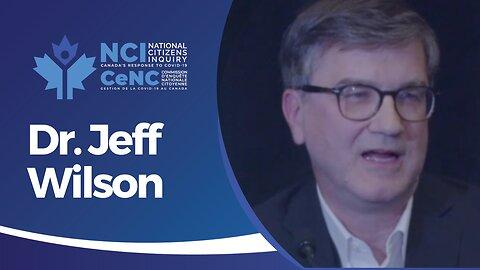Dr. Jeff Wilson has a company called Novametrix that is designed to bring together networks of people to solve complicated problems. He explains, “What we did was we developed a process, which is part business process, part social psychology, to bring people together coherently to solve these problems. We call it CNI [Community Network Integration].”
* The above video is being streamed via Rumble. Check back often as we continue to update the complete list of links to all witness testimonies in both video and audio/podcast formats.
[00:00:00]
Kassy Baker
Mr. Wilson, welcome. Can you please state and spell your name for the record?
Dr. Jeff Wilson
Yeah, it’s Jeff Wilson, J-E-F-F W-I-L-S-O-N.
Kassy Baker
And do you promise that you will tell the truth, the whole truth, and nothing but the truth this afternoon—or morning, pardon me?
Dr. Jeff Wilson
I do.
Kassy Baker
Very good. Now I understand that you’re here to talk to us today about the pillars of outbreak response. Before we get into that can you please just give me a little bit more information about yourself, including your education and your career up until this point?
Dr. Jeff Wilson
Yeah. By training I’m a veterinarian. I also have doctorates in pathology and I have a PhD in Epidemiology, Public Health, and Infectious Disease. I was a professor of public health/epi. at the University of Guelph for nearly 18 years. I was cross-appointed to what’s now the Public Health Agency of Canada [PHAC], started the group which does foodborne, waterborne, and zoonotic disease epidemiology, including outbreak response.
And particularly, I think why I’m here is I’m one of the very few people in Canada who actually understand outbreak response—how it’s done. And I may be the only one who’s actually stepping forward and talking about it in the context of COVID.
I just add, understanding what to do about COVID and understanding how to prepare for subsequent pandemics is— In order to do that, it’s absolutely essential to understand how to run an outbreak. Without that, we will just continue to swirl indefinitely—complaining about government, complaining about pharma, recounting our tragic stories, but nothing will change. That’s why I’m here.
Kassy Baker
Very good. Now I understand that you in particular were involved with the outbreak in Walkerton. Can you briefly tell us a little bit about that as we go into your presentation?
Dr. Jeff Wilson
Sure. Anybody over 30 probably has heard of the Walkerton outbreak. Before COVID, it was the most famous outbreak in Canada. Seven people died; half the town got violently ill.
I had taken the PHAC field epidemiology training program for two years and then I was heavily involved in managing those outbreaks. I was asked by the medical officer responsible for Walkerton to come in and help out with the epidemiology, so we ran the epidemiology for it.
Kassy Baker
Okay. Now of course that was a waterborne illness.
Can you explain to us just briefly—and perhaps you’ll get into this in a little bit more detail—how that is different, or alike, with a respiratory illness such as COVID?
Dr. Jeff Wilson
Right. It’s one of these things. All outbreaks are fundamentally the same and their management is fundamentally the same, but they all have differences. But the key to managing outbreaks is not to focus on the differences, it’s to focus on the commonality of the process.
Walkerton was a waterborne disease outbreak. It’s what we call a point source outbreak. Person-to-person transmission was not a major part of it. It was mainly caused by drinking water. And it was caused by a bacterium, not a virus.
Kassy Baker
Those are all my questions. Are you prepared to start your presentation [Exhibit OT-8] at this point?
Dr. Jeff Wilson
Sure. I know there’s a time crunch so I’m going to move through reasonably quickly here. I’m president of Novometrix now, that’s my company. It’s a social enterprise. We link networks together to solve complex problems. Because of things like COVID, they have to be solved by bringing people together—including people who have differences of opinion, which is also key to management of this whole thing.
As we work through an outbreak—and particularly as we’re coming now into the “lessons learned” phase—it’s very important to recognize that we have to move from the critical evaluation phase, i.e., “What went wrong?” That’s important, but it’s not enough.
We have to now move into the “What do we do now?” phase. The world is just starting to get thinking in my opinion, about what we’re going to do now.
We can make a bunch of recommendations out of a group like this or from the federal government or anything else.
[00:05:00]
The problem is: How do you get the recommendations implemented? This is critical. Without that we will just all be frustrated. And what happens in the future? It’s not good enough simply to— Even if we could fix up the COVID situation, what if there’s a new bug, a new drug, or yet another novel form of government or corporate or citizen dysfunction? How do we solve those problems? Well, I’ll flip through this.
Basically, how [do] you solve problems that are new? And Canadians largely are. When they’re working with things like COVID, it’s new to most Canadians. It’s not new to somebody like me because I’ve done it many times before. What you do when you’re dealing with something new, you talk to people who actually have done the thing. Doctors, physicians are normally not trained in outbreak response. Nor are immunologists. Nor are politicians.
There’s a very small group of people who are trained in how to do this. They have training in outbreak response. This is not just patting myself on the back. We need to listen to actually how to do this and how to prepare for the future or we will fail, potentially with very disastrous consequences.
Fortunately, there is a very well-established protocol for how you manage outbreaks. Canada has managed hundreds and hundreds of outbreaks successfully, like Walkerton. Thousands have been managed successfully around the world. There are textbooks written on this. The Public Health Agency of Canada has a two-year mentorship program on how to do this. It’s known what to do. What happened in Walkerton was we simply didn’t do it.
In order to change this, what we want to do is start focusing on what we do want, which is proper outbreak response, not simply churning our pain and frustration and description of what we didn’t like or what didn’t appear to work. It’s important, but now we need to move on. So that’s what I’m about. We call the process the Pillars of Outbreak Response.
These are the pillars. Build proper leadership teams. If you think about it, you may recall there was never identified a leadership team for COVID. Those leadership teams have to be transparent. They have to include all of the correct people who know how to do this: the medical community, business community, all the different players. We didn’t do that. If we don’t do that, we will fail.
Once you’ve put in place proper leadership— And this is absolutely known in outbreak response, so in Walkerton, this is job one: Make the leadership team. Make it transparent. Make it inclusive. Have the right people around the table. Then after that, a lot of it’s technical. It’s based on proven principles.
Then I go, “Okay. My problem with this is, I’m one of maybe five people in Canada who have actually done this, who actually can see that with COVID, it failed.” Most of those people I know are people that I trained. Also my boss, who helped to train me.
It’s essential that we get this into the minds of people, like in this group but also in public health and the public in general and the media. So people can actually understand what to do. Otherwise, we’ll just repeat; we’re absolutely destined to repeat what we’re doing in a new form.
So my question is: How do I do that? How do I explain how to properly manage an outbreak? Well, what I’ve decided to do is I’ll show you how we ran Walkerton and why it worked. And then we’ll go, “Now this is what we should have done with COVID.” COVID is done now, largely. Now we have to prepare, put in place all the tools so we can do this nationally in preparation for the next one, or whatever other debacle we encounter.
So I’m going to talk briefly about Walkerton. I think everybody knows it was a bad outbreak caused by bad water. As I’m doing this, what I’m hoping is, the bells can go off and people can go, “Oh, there’s actually a known process that we could have done with COVID,
[00:10:00]
and we for some reason didn’t do it?” Yes. The answer is not mysterious, it’s not even complicated. So as you’re working through this in your mind, you can think, “Okay, could this apply to COVID? Could we do that? Could we have done this with COVID? Can we do this with influenza if that’s the next one? Can we do it with another one?” If we don’t start thinking this way, we’re done. And we could easily have a next one which is vastly more virulent than COVID.
We got off—I know it was ridiculous, it was bad—but we got off easy because it was a relatively non-virulent bug. Now that’s not— Obviously anybody who suffered from this, I totally accept that and empathize with that. But the reality is that is nothing compared to what is on the table, okay? And that’s just— That’s well known within the medical community.
So we built the leadership team. How do we do this? We actually connected out to these people in Walkerton: local public health, physicians, pharmacists, local government, public health agency, Ontario Public Health, the Ministry of Agriculture, multiple academics. We actively sought out multiple academics with different opinions so we could figure out what was going on. This is standard, standard practice in outbreak response.
We had to bring in the RCMP because there was a bunch of malfeasance going on. We brought in local politicians—but the relationship with them was managed. Because everyone running an outbreak knows you can’t have the mayor or the premier running an outbreak because it will fail. Because they don’t know anything about outbreak response, of course, or rarely do they and they have ulterior— They just have, they’re incentivized differently. Because they’re primarily incentivized to get votes, not to solve problems actually, of any kind. I’m not trying to insult politicians, I’m going: that’s the system we’ve got.
Then we started building an evidence base. We got the right tests in place. You’ve heard about the PCR test for COVID. That’s not— I’m not an expert in the PCR test, but I know enough about it— I’m able to talk to a lot of different people because my job is outbreak response, which is mainly a management and leadership job, not a “knowing every answer” job. It’s bringing in the right people, not prescriptively saying, “Hey, this is the best vaccine” or what have you. So you have to get the right test in place, then you have to start building an evidence base.
I’ll go through what that means. You actually have to find out: who’s sick, how many people are sick, what is causing it? How can you put in place interventions if you don’t actually know what is causing the problem? Does that make sense?
So the tests. The main bug was E. coli O157. A PCR test was available, but everybody in the field knew that it wasn’t nearly as good a test as simply culturing the bacteria on a plate because that’s well established and has much lower problems with false positives and false negatives. So you have to actually put that in place.
If we’re going to be preparing for the next bug, we have to have an ability to get the right experts together and find those right tests based on the evidence. Based on the evidence, not based on what you’re reading in the paper, not based [on] what your sister-in-law says, but on the actual evidence.
And as a community, the people need to understand this: Politicians will not do this for us. Pharma will not do this for us. The church will not do this for us. We have to do it. And that means we the people have to understand this stuff—or we are done. Because we have to build an accountability for it and it has to be done community by community. There’s nobody out there that’s going to fix this for us.
You bring together the right literature. So that means the team comes together once a week. They start looking at the problem. They start going, “Okay, what’s known about this in the literature?” They bring in the proper literature and it’s all stored in one place. If you do that, then you don’t get alternative sides hurling their literature over the ramparts to attack the other person. It’s all in one place and it’s transparent, under transparent leadership.
[00:15:00]
You have to bring the data and the papers together. This is critical stuff. Whether or not to vaccinate is critical, but without this, it will be impossible to determine whether to vaccinate and it’ll be impossible to get consensus on what to do about vaccination.
That’s what happened during this thing. It was primarily a leadership and management debacle, where I consider all of us to be complicit. Because we’re members of the public and we didn’t see this coming and we bought into a system, which some of us are not buying into any more. But we were complicit in allowing this to take place.
No more. It’s about leadership. All of us have to take leadership—personally. And that means we have to understand how this works or we’re potentially dead.
Very briefly, as you bring a leadership team together and you have proper tests, you can start testing people in the community. And then you can find out who’s actually sick, who’s actually dying. Not sick with E. coli, but sick due to E. coli. This is critical. And actually infected—not a false positive. You start building out that as a series of spreadsheets with actual people’s names. This is exactly what we did in Walkerton and this is the kind of thing that must be done in— we have to be prepared for this for the next pandemic.
Then we start asking people about what are called “risk factors.” We simply question them about—Did you drink the water? Did you play in a swimming pool? Did you squirt water with a squirt gun at your brother? Did you eat hamburger? Did you pet a calf? All of that data, hundreds and hundreds of variables, all went into a coherent database that was shared with the whole leadership team, which represented all the key stakeholders.
With that in place then they just— Our team simply started doing some simple correlations. They found, “Oh look, being actually infected with E. coli is correlated with 15 measures of exposure to the water.” But it wasn’t correlated with drinking bottled water, or swimming in a swimming pool in a neighbouring county. People are, “Okay, this is definitely looking like the water.”
Then some things came up like, well, it seems that eating hamburger is a minor risk factor for this. And so is having a kid in daycare. Then what happens— And again, you never saw in this thing, although it’s basic, basic stuff at the health unit level to run those associations, they’re called attack rate tables. They all know it. I can tell you right now they’re running out foodborne disease outbreaks and they’re doing those things. But they never did it with COVID. Why is another question. But anyway, we have to now start having these things done.
Then they did a multivariable model where they put all this stuff into a big model, and the only one that came up positive was the water. Now they knew that it was the water. You can’t possibly manage something like Walkerton if you don’t know where it’s coming from. There’s no point in guessing that it’s coming from a cow or that it’s person-to-person and then putting in place an E. coli vaccine program or something ridiculous. If you follow the steps—starting with a leadership team and then collecting the right data and doing the analysis—all the things fall out into place.
Briefly, in Ontario certainly a huge deal was made about using predictive spreadsheet modelling. I’m an epidemiologist. I have a PhD in this. Spreadsheet models are good for some things. They are not very good at all for predictive modelling of infectious diseases where we know nothing about the disease or the risk factors. This movement to using spreadsheet models as predictors, it’s just— like, this is actually a first-year epidemiology undergraduate exam question.
Disinformation, there was lots of misinformation. People lied. There were lawsuits.
The interventions. Once we could tell what it was,
[00:20:00]
we didn’t have to run around and try and fix up daycares and stop you from touching cows. The medical officer just put in a boil water order. The cases went down. Then we put in place more of this epidemiology and we found out the exact—analytically, where it was coming from. Then they shut down the well. It was over.
Communications, the fourth pillar. Everybody who runs outbreaks knows that communication has to be complete; it has to be correct; it has to be transparent. This is all in textbooks. This is all in the PHAC field epidemiology training program. That’s where I learned it from some of the best in the world. It has to be multidirectional by everybody.
Might Walkerton have descended into chaos? Absolutely. It could have been just an utter debacle. Why wasn’t it? Proper leadership by people who understand the pillars of outbreak response.
It’s literally like if you had your grandmother in the kitchen and a bunch of the neighbours came together in the family and said, “We think she needs brain surgery.” They’re starting to say, “Well, anybody know anything about brain surgery?” “Well, I watched it on TV once. I think we should just start opening up her head.” A brain surgeon is actually in the room and he says, or she says, “I don’t think that’s a good idea.” That’s what the pillars of outbreak response are. This is why people need to understand this.
COVID? I would just go, “every pillar was violated, every single one, by people who know better.”
The details matter. It doesn’t count to say some leadership meetings happened, some data were collected, some interventions were tried, some communications happened. The pillars only work when they’re done properly by people that know what they’re doing. With a proper leadership team for something like COVID—of course vaccination as an option comes onto the table, but it’s managed coherently based on the risk factor data. And then it’s implemented with a coherent team that includes not just vaccine proponents but other people who know a bunch of stuff about vaccines.
Kassy Baker
I just wanted to let everyone know that we do have a hard stop at noon today, which gives us ten more minutes. I’m sure that we’ll have some questions that— I just want to make sure we save a bit of room for the commissioners. Thank you.
Dr. Jeff Wilson
In the interest of brevity, the question then becomes: Can you run something as big as COVID like we ran Walkerton?
I’m here to say, the main difference between Walkerton and COVID is the size. It’s the number of people. When you have something that’s big, all manner of opportunities for confusion, malfeasance, gaming the system, fear, and whatnot come into play.
What you need to do then is to actually have a way to bring the people of Canada together. Starting with groups like this but also like-minded people within the public health system, the academic system, and members of the public. You might go, “Well, that sounds like a hard thing. How are we going to bring everybody together?” It is a hard thing and it’s a new thing, but it’s absolutely essential. In Walkerton, we brought a hundred people together to manage this. In Canada, we’ve got thousands to help millions.
What our company did was: After watching things like Walkerton and working as a pharmaceutical consultant and an academic and a whole bunch of other stuff, I realized that our primary problem is that all the easy problems are solved. We know how to chlorinate the drinking water. What remains are wicked problems. They’re complex. And to solve them, you need to bring together a lot of stakeholders.
What we did was we developed a process, which is part business process, part social psychology, to bring people together coherently to solve these problems. We call it CNI [Community Network Integration]. I’ve been working on this with our team and multiple networks across Canada like Kyle alluded to.
[00:25:00]
To start showing people how to do this. One of those, as Kyle mentioned, is the avian influenza network. Now you might say, what does avian influenza have to do with COVID? Well, let’s think. What might be the thing? Well, it might be the next pandemic, right?
What I discovered was that I could start bringing together the— I’ve already begun, and our team is going to bring together the public health people to solve things like COVID.
But COVID is so triggering for people, if I go to the mayor of Guelph or the head of the poultry association and say “COVID,” the word makes them go apoplectic. What we did was we said, “What issues would you like to work on?” Because I know a lot of people in the poultry network and I could see it’s very parallel to solving COVID. They said, “We want to work on avian influenza.” It turns out, now, we’ve brought together most of the major players across Canada in that network. It’s solving a chicken disease problem, but it’s also a potential public health problem. Everything that I described that we did in Walkerton, we have the leadership teams coming together. We have the data frameworks coming together. We have the initial pilot projects. We even have ways to fund it through industry, through crowd funding, because we’re setting it up so it actually makes money. We even have pharma as part of it—but they’re on a tight leash—and they’re funding it.
I wanted people to see this is very real. This is the kind of thing that— Theresa Tam, who I know quite well, connected me to Howard Njoo. PHAC is now a part of this because they want to bring in and understand better how to manage outbreaks.
Kassy Baker
Sorry, just on that note, we have three minutes left. I think I have to—
Dr. Jeff Wilson
It’s all good. If there are any questions, I’d be happy to answer them.
Kassy Baker
Very good. Do we have any questions? Okay. We have one.
Dr. Jeff Wilson
And I apologize for my stridency, but anyway—
Commissioner Massie
Yeah, I have a couple of question which— I really like your model. I think it can work except for the one variable which is very difficult, which is the human element. And I’m going to bring something that was mentioned by many other witnesses at this Commission, which is the conflicts of interest that really corrupt a well-functioning or well-intended process. Because people that are at the table—that have some expertise and knowledge that can contribute—are trying to move the agenda towards what they would want to see for their own benefit. So how do you ensure that the conflict of interest of such a fantastic network is not going to be derailing the network?
Dr. Jeff Wilson
I’ll try to give a brief answer. There’s a few moving parts to it.
With the poultry network, for example, what we did was we decided we’re running this network. It’s going to be collaborative and transparent, and we simply will not allow conflict of interest—there’s always some, but significant conflict of interest—in the network. I simply started connecting to people across the network—so people in public health, animal health—and I told them, “Here’s what we’re doing.” I said, “You know how this avian influenza thing is a big problem and we’re only going to solve it if we come together.” And I brought together, to begin with, the people who psychologically don’t like to do conflict of interest. We started at that point, but some of them are major players in the industry and in public health. They all said, this is exactly like you’re saying: “Jeff, this is a good idea. We have to stop this.”
The first step was, we simply named it as part of the leadership framework: “Everything here will be transparent—excluding, you know, proprietary secrets that are legitimate. It’s all going to be transparent and we simply won’t allow— we love you dearly, but we’re not going to allow backstabbing, cheating, lying, stealing, or any of that stuff.”
And you know what people said? They said, “Excellent,
[00:30:00]
what an amazing idea.”
And then we started building it out from there. So I broached people in pharma. I’ve worked in the pharmaceutical industry for years. There are really good people in pharma and there are really bad people in pharma. I reached out to a bunch of them who I know are good people and I explained what we’re doing. And they said, “Excellent. Finally, someone who’s disrupting all the malfeasance across our industry, including from pharma.”
Now they like that. And they also can see they can be part of a network which will help with their sales, for example, but only if they are transparent and actually work to contribute to the whole. And you might go, “Why would that work?” I’d say, “Come join our poultry network and I’ll show you.” And I’m quite serious.
Commissioner Massie
My second question, which I think you illustrate in your model at Walkerton, I think it’s a very nice illustration. Because we had other people at the testimony that were talking about this whole notion of epidemic versus pandemic.
And the question was: Given the environment, the complexity of the environment, the territory, the people there, and all of the encounters of—in the case of COVID—the respiratory virus, how can we propose a one-size-fits-all model top-down?
Dr. Jeff Wilson
You can’t. It makes no sense.
Commissioner Massie
And why is it that we’ve been trapped in that mindset?
Dr. Jeff Wilson
Mass stupidity, I would say. I’m being irreverent obviously; there’s different names for it. But I kind of think the level of fear and greed and just overwhelm came to the point where it normalized highly dysfunctional destructive behaviour, which is now threatening to take down pharma. And the federal government.
Is that helpful at all?
Shawn Buckley
Commissioners, I’m sorry to interrupt, but because we have to vacate this room at six o’clock and the schedule that we have— You’ll see that with every witness, we’ve been really tight on the timeline. I had to apologize to Dr. Shoemaker, I apologize to you.
I’m going to suggest that we do take a lunch break but a truncated one for 35 minutes. And commence early. Because some of the estimates on our witness schedule you’ll see are not very optimistic and we have a hard stop. And we want to protect those closing statements from several people. So I’m going to adjourn us to 12:35.
[00:32:48]
Final Review and Approval: Jodi Bruhn, September 6, 2023.
The evidence offered in this transcript is a true and faithful record of witness testimony given during the National Citizens Inquiry (NCI) hearings. The transcript was prepared by members of a team of volunteers using an “intelligent verbatim” transcription method.
For further information on the transcription process, method, and team, see the NCI website:
About these Transcripts
- Veterinarian PhD in pathology
- PhD in epidemiology, public health, and infectious disease
- Professor of public health epidemiology at the University of Guelph 18 years.
- Public Health Agency of Canada, started the group which does foodborne, waterborne, and zoonotic disease epidemiology, including outbreak response.
- President of Novometrics Research Inc.
SUMMARY: Dr. Wilson gave a presentation on the Pillars of Outbreak Response
Summary
Dr. Wilson gave a presentation on the Pillars of Outbreak Response. The Pillars were developed based on experience with previous outbreaks, and he used the Walkerton outbreak often as an example of their successful application. The Pillars include Leadership teams; Tests, literature and data framework, analysis; Treatment and prevention; and Communications. The Pillar framework was not followed or used at all in the COVID outbreak.
Dr. Wilson outlined the shortcomings of the COVID response in terms of the failure to meet these outbreak response requirements. If lessons are not learned, expect the same results with the next outbreak.
While he considers COVID to be primarily a leadership and management debacle, all Canadians were complicit. We bought into the predominant COVID narrative. We need to all accept some responsibility for what went wrong, and we need to build accountability back into existing systems to avoid a repeat.
Endeavours like the National Citizens Inquiry are a start to building accountability. What he thinks needs to be done is to expand accountability to stakeholders in key communities such as public health, education, business and media.
He stated that his company is attempting to address some of these response shortcomings in a roundabout way, by working now with key stakeholders in the avian influenza network (avian influenza may be one of the next pandemics). He has achieved some success in this, and his results, he feels, can translate into a framework for any future outbreak, without triggering the negativity that many people associate with COVID.






















